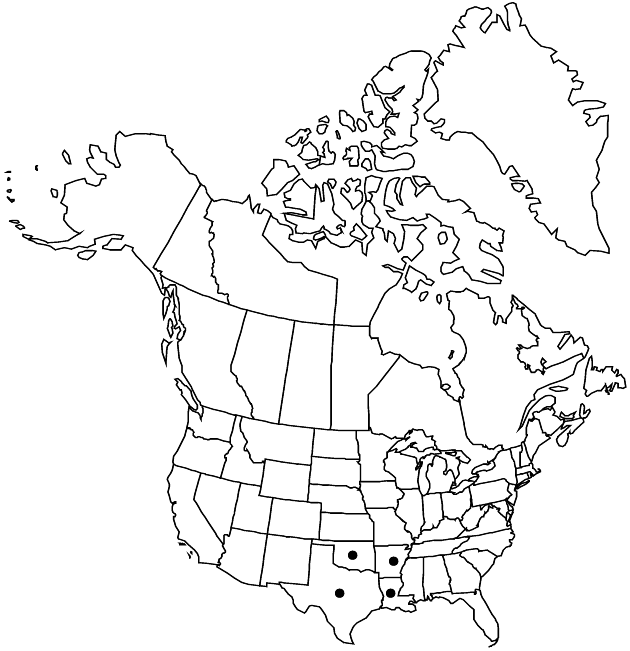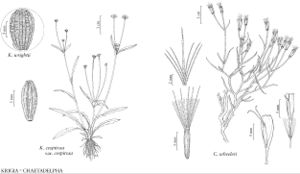Difference between revisions of "Krigia wrightii"
Brittonia 44: 195. 1992.
FNA>Volume Importer |
FNA>Volume Importer |
||
| Line 27: | Line 27: | ||
|elevation=10–300 m | |elevation=10–300 m | ||
|distribution=Ark.;La.;Okla.;Tex. | |distribution=Ark.;La.;Okla.;Tex. | ||
| − | |discussion=<p>Krigia wrightii grows in the Eastern deciduous forest biome, southeastern Coastal Plain, tallgrass prairie, and mixedgrass prairie. It was confused with K. cespitosa by L. H. Shinners (1947); its cypselae, involucres, and chromosome number set it apart. It often grows sympatrically with K. occidentalis or K. cespitosa, and mixed collections may occur.</p> | + | |discussion=<p><i>Krigia wrightii</i> grows in the Eastern deciduous forest biome, southeastern Coastal Plain, tallgrass prairie, and mixedgrass prairie. It was confused with <i>K. cespitosa</i> by L. H. Shinners (1947); its cypselae, involucres, and chromosome number set it apart. It often grows sympatrically with <i>K. occidentalis</i> or <i>K. cespitosa</i>, and mixed collections may occur.</p> |
|tables= | |tables= | ||
|references= | |references= | ||
| Line 51: | Line 51: | ||
|publication year=1992 | |publication year=1992 | ||
|special status= | |special status= | ||
| − | |source xml=https://jpend@bitbucket.org/aafc-mbb/fna-data-curation.git/src/ | + | |source xml=https://jpend@bitbucket.org/aafc-mbb/fna-data-curation.git/src/8f726806613d60c220dc4493de13607dd3150896/coarse_grained_fna_xml/V19-20-21/V19_583.xml |
|tribe=Asteraceae tribe Cichorieae | |tribe=Asteraceae tribe Cichorieae | ||
|genus=Krigia | |genus=Krigia | ||
Revision as of 16:13, 18 September 2019
Annuals, 4–25 cm; taprooted. Stems erect, branching proximally and distally, leafy, eglandular or stipitate-glandular, especially distally. Leaves basal (rosettes) and cauline; blades broadly to narrowly oblanceolate, 1–10 cm, margins entire or remotely dentate or lobed, lobes acute or rounded, apices acute to obtuse, faces eglandular or lightly glandular-villous. Heads borne singly. Peduncles from branching, leafy stems. Involucres 3.5–5.5 mm. Phyllaries 5–9, erect in fruit, narrowly to broadly lanceolate, midveins becoming prominent in fruit, curving inward at bases to form keels, apices acute. Florets 5–25; corollas yellow, 4–7 mm. Cypselae reddish brown, broadly columnar or barrel-shaped, 1.3–1.6 mm (apices slightly constricted, apical areas broader than basal areoles), 15-ribbed; pappi 0, or coroniform (minute scales, rarely with 1–5 tiny bristles). 2n = 18.
Phenology: Flowering Mar–May.
Habitat: Sandy, clay, loam, and rocky soils, fields, pastures, prairies, hillsides, and open oak-hickory and pine woods. sometimes in disturbed areas
Elevation: 10–300 m
Distribution

Ark., La., Okla., Tex.
Discussion
Krigia wrightii grows in the Eastern deciduous forest biome, southeastern Coastal Plain, tallgrass prairie, and mixedgrass prairie. It was confused with K. cespitosa by L. H. Shinners (1947); its cypselae, involucres, and chromosome number set it apart. It often grows sympatrically with K. occidentalis or K. cespitosa, and mixed collections may occur.
Selected References
None.
